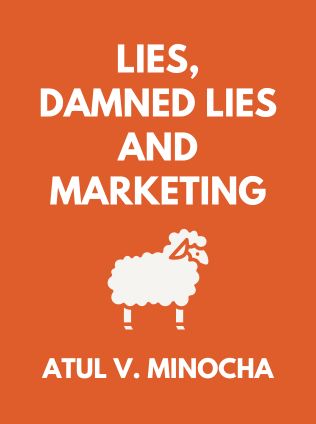
Lies, Damned Lies, and Marketing
Separate Fact from Fiction and Drive Growth
By Atul V. Minocha
Published 08/2021
About the Author
Atul V. Minocha, a partner at Chief Outsiders, brings decades of marketing experience to the table. He has worked with both startups and Fortune 500 companies, including Honeywell, Kodak, and Toyota, across various industries such as automotive, healthcare, industrial goods, and technology. Minocha holds a degree in mechanical engineering from the Indian Institute of Technology Delhi and an MBA from Yale University. He is a professor at the Hult International Business School, a mentor, an angel investor with Sierra Angels, a Vistage speaker, and a Forbes contributor. His book, "Lies, Damned Lies, and Marketing," aims to help businesses separate marketing fact from fiction and drive growth through strategic and effective marketing practices.
Main Idea
"Lies, Damned Lies, and Marketing" by Atul V. Minocha provides insights into identifying and plugging the "leaky holes" in marketing strategies, distinguishing between effective and ineffective marketing practices, and leveraging a blend of data and creativity to drive business growth.
Table of Contents
- What is Marketing?
- Big-M Marketing
- Small-m Marketing
- Big-M + Small-m Marketing
What is Marketing?
Marketing is described as a bridge connecting businesses with their customers and potential customers. Minocha distinguishes between Big-M marketing, which defines business strategy, and small-m marketing, which involves visible tactics such as websites, logos, and advertisements.
Understanding the Difference
Big-M marketing encompasses foundational elements that define a company's strategic approach, while small-m marketing focuses on tactical implementations that drive immediate results. Minocha emphasizes the importance of having a comprehensive understanding of both to achieve marketing success.
Minocha writes,
"Big-M marketing refers to the foundational aspects that help define your business strategy. Small-m marketing refers to the tactics you can implement to move the needle." – Atul V. MinochaBy recognizing the distinction and integrating both approaches, businesses can create a cohesive marketing strategy that aligns with their overall goals.
Big-M Marketing
Big-M marketing combines data and emotion to create a powerful marketing strategy. Minocha outlines a four-step process:
- Emotional Appeal: Start by relating to the audience's pain points and desires.
- Benefits List: Provide a concise list of product or service benefits.
- Proof Points: Use testimonials, demos, and data to substantiate claims.
- Track & Measure: Monitor key metrics to gauge audience response.
He also discusses the predictability of human irrationality, citing Dan Ariely's "Predictably Irrational," and the need for businesses to focus on niches while maintaining diversity to avoid cyclicality.
Left Brain and Right Brain Synergy
Minocha highlights the importance of balancing analytical data with emotional connections to craft effective marketing strategies. By understanding both the rational and irrational aspects of consumer behavior, businesses can create more compelling marketing campaigns.
Sign up for FREE and get access to 1,400+ books summaries.
You May Also Like
The Lean Startup
How Today's Entrepreneurs Use Continuous Innovation to Create Radically Successful Businesses
By Eric RiesWho Moved My Cheese?
An Amazing Way to Deal with Change in Your Work and in Your Life
By Spencer Johnson, M.D.Make Your Bed
Little Things That Can Change Your Life...And Maybe the World
By William H. McRavenThe Ride of a Lifetime
Lessons Learned from 15 Years as CEO of the Walt Disney Company
By Robert Iger



















